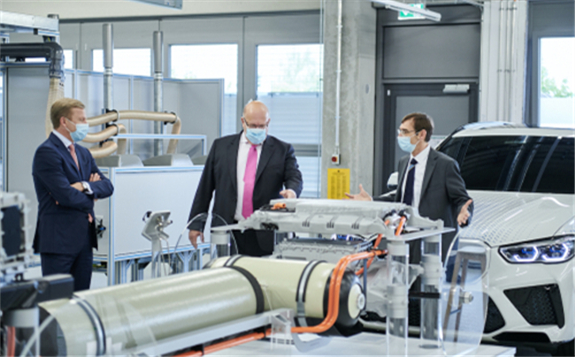The BMW Group will pilot the second generation of hydrogen fuel cell drives in a small series in the BMW i Hydrogen NEXT based on the current BMW X5 from 2022. The fuel cell stack and the overall system are original developments of the BMW Group; individual cells of the fuel cell will come from Toyota.
The BMW Group has been working with Toyota Motor Corporation on fuel cell drive systems since 2013. Since summer 2015, the BMW Group has been testing development vehicles based on the BMW 5 Series GT, which are equipped with a jointly developed fuel cell system.
In the future, the hydrogen fuel cell drive can be an attractive alternative to battery-electric vehicles, in particular for customers who do not have their own access to electric charging infrastructure and who often drive long distances, BMW said. With a sufficient refueling infrastructure, hydrogen vehicles offer great flexibility, as the full range is available again after a short refueling process of around four minutes regardless of temperature conditions.
 CEO of BMW AG, Oliver Zipse; Federal Minister of Economics Peter Altmaier; Jürgen Guldner, Head of Hydrogen Technology and Vehicle Projects at the BMW Group's Hydrogen Competence Center.
CEO of BMW AG, Oliver Zipse; Federal Minister of Economics Peter Altmaier; Jürgen Guldner, Head of Hydrogen Technology and Vehicle Projects at the BMW Group's Hydrogen Competence Center.
The drive in the BMW i Hydrogen NEXT. The system performance of the BMW i Hydrogen NEXT comes to a total of 275 kW (374 hp) and ensures typical BMW driving dynamics. The fuel cell system alone generates up to 125 kW (170 hp) of electrical energy, says Jürgen Guldner, Head of the BMW Group Hydrogen Fuel Cell Technology and vehicle projects.
The electrical converter, which is located below the fuel cell, adjusts its voltage level to that of the electrical drive and the power buffer battery. This is fed by the braking energy and the energy of the fuel cell.
Two 700 bar tanks are housed in the vehicle itself, which together hold six kilograms of hydrogen.
The fifth-generation electric drive, which is used for the first time in the BMW iX3, is also fully integrated in the BMW i Hydrogen NEXT. The power buffer battery, which is positioned above the electric machine, can provide additional dynamics when overtaking or accelerating, for example.
BMW Group in the BRYSON research project. The BMW Group also underscores the belief in the future viability and potential of hydrogen fuel cell technology with its involvement in the BRYSON research project (space-efficient HYdrogen storage facilities with optimized usability).
The aim of this collaboration between BMW AG, Munich University of Applied Sciences, Leichtbauzentrum Sachsen GmbH, Dresden University of Technology and WELA Handelsgesellschaft mbH is to develop new types of hydrogen storage tanks. These should be designed so that they can be easily integrated into universal vehicle architectures.
The aim of the project is the development of flat tank tanks. The 3.5-year project, which is also funded by the Federal Ministry for Economic Affairs and Energy, will also result in a reduction in the manufacturing costs of hydrogen tanks for fuel cell vehicles. This will improve their competitiveness compared to battery electric vehicles.